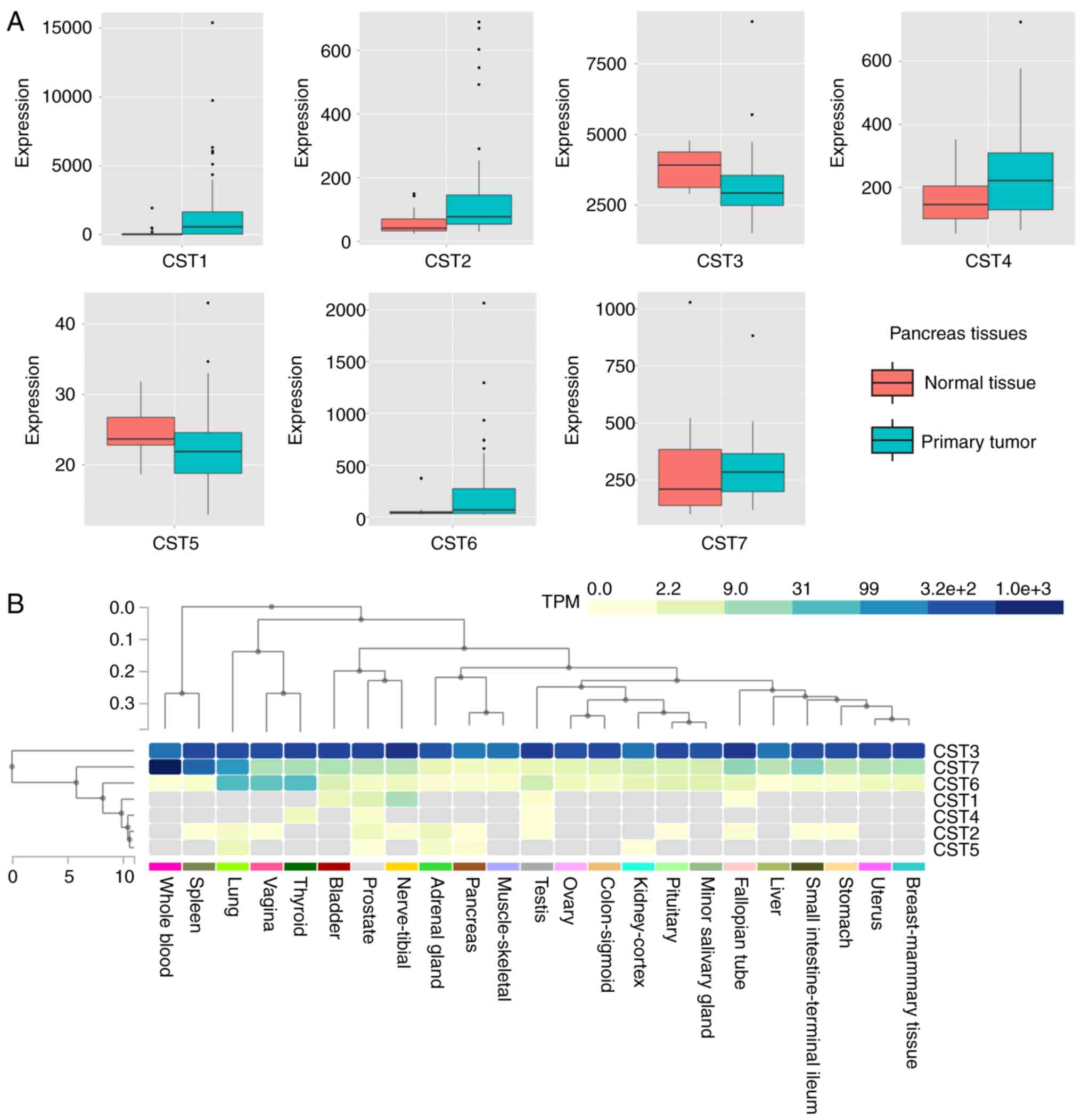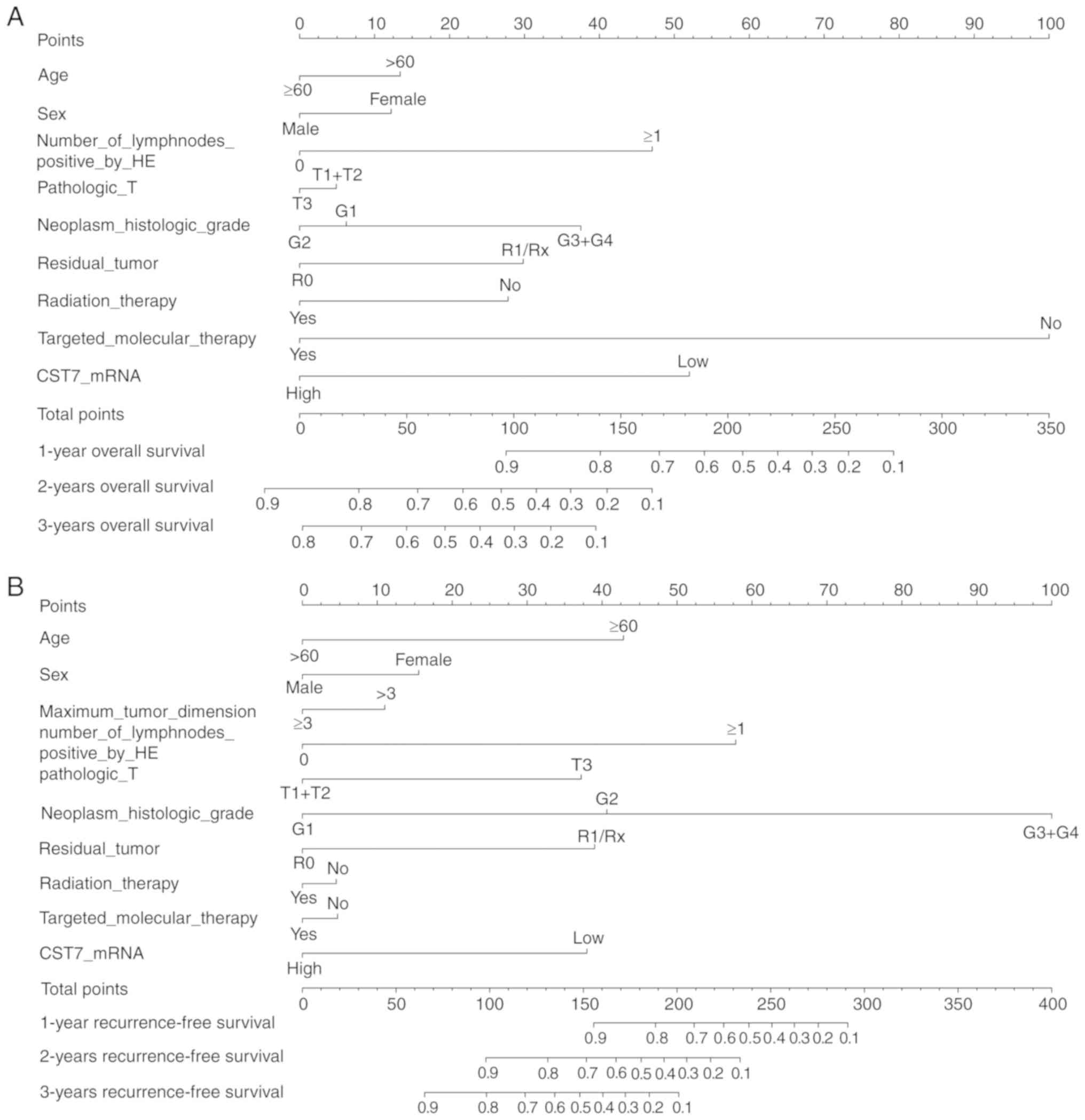|
1
|
Li D, Xie K, Wolff R and Abbruzzese JL:
Pancreatic cancer. Lancet. 363:1049–1057. 2004. View Article : Google Scholar : PubMed/NCBI
|
|
2
|
Siegel R, Naishadham D and Jemal A: Cancer
statistics, 2012. CA Cancer J Clin. 62:10–29. 2012. View Article : Google Scholar : PubMed/NCBI
|
|
3
|
Jemal A, Siegel R, Ward E, Murray T, Xu J
and Thun MJ: Cancer statistics, 2007. CA Cancer J Clin. 57:43–66.
2007. View Article : Google Scholar : PubMed/NCBI
|
|
4
|
Siegel RL, Miller KD and Jemal A: Cancer
statistics, 2017. CA Cancer J Clin. 67:7–30. 2017. View Article : Google Scholar : PubMed/NCBI
|
|
5
|
Conrad C and Lillemoe KD: Surgical
palliation of pancreatic cancer. Cancer J. 18:577–583. 2012.
View Article : Google Scholar : PubMed/NCBI
|
|
6
|
Vincent A, Herman J, Schulick R, Hruban RH
and Goggins M: Pancreatic cancer. Lancet. 378:607–620. 2011.
View Article : Google Scholar : PubMed/NCBI
|
|
7
|
Choi EH, Kim JT, Kim JH, Kim SY, Song EY,
Kim JW, Kim SY, Yeom YI, Kim IH and Lee HG: Upregulation of the
cysteine protease inhibitor, cystatin SN, contributes to cell
proliferation and cathepsin inhibition in gastric cancer. Clin Chim
Acta. 406:45–51. 2009. View Article : Google Scholar : PubMed/NCBI
|
|
8
|
Travis J and Potempa J: Bacterial
proteinases as targets for the development of second-generation
antibiotics. Biochim Biophys Acta. 1477:35–50. 2000. View Article : Google Scholar : PubMed/NCBI
|
|
9
|
Koblinski JE, Ahram M and Sloane BF:
Unraveling the role of proteases in cancer. Clin Chim Acta.
291:113–135. 2000. View Article : Google Scholar : PubMed/NCBI
|
|
10
|
Kos J and Lah TT: Cysteine proteinases and
their endogenous inhibitors: Target proteins for prognosis,
diagnosis and therapy in cancer (review). Oncol Rep. 5:1349–1410.
1998.PubMed/NCBI
|
|
11
|
Verbovšek U, Van Noorden CJ and Lah TT:
Complexity of cancer protease biology: Cathepsin K expression and
function in cancer progression. Semin Cancer Biol. 35:71–84. 2015.
View Article : Google Scholar : PubMed/NCBI
|
|
12
|
Cox J: Cystatins as regulators of cancer.
Med Res Arch. 5:2017. View Article : Google Scholar
|
|
13
|
Barrett AJ: The cystatins: A new class of
peptidase inhibitors. Trends Biochem Sci. 12:193–196. 1987.
View Article : Google Scholar
|
|
14
|
Henskens YM, Veerman EC and Nieuw
Amerongen AV: Cystatins in health and disease. Biol Chem Hoppe
Seyler. 377:71–86. 1996.PubMed/NCBI
|
|
15
|
Abrahamson M, Alvarez-Fernandez M and
Nathanson CM: Cystatins. Biochem Soc Symp. 179–199. 2003.
View Article : Google Scholar : PubMed/NCBI
|
|
16
|
Chimonidou M, Tzitzira A, Strati A,
Sotiropoulou G, Sfikas C, Malamos N, Georgoulias V and Lianidou E:
CST6 promoter methylation in circulating cell-free DNA of breast
cancer patients. Clin Biochem. 46:235–240. 2013. View Article : Google Scholar : PubMed/NCBI
|
|
17
|
Cao X, Li Y, Luo RZ, Zhang L, Zhang SL,
Zeng J, Han YJ and Wen ZS: Expression of Cystatin SN significantly
correlates with recurrence, metastasis, and survival duration in
surgically resected non-small cell lung cancer patients. Sci Rep.
5:82302015. View Article : Google Scholar : PubMed/NCBI
|
|
18
|
Alvarez-Díaz S, Valle N, García JM, Peña
C, Freije JM, Quesada V, Astudillo A, Bonilla F, López-Otín C and
Muñoz A: Cystatin D is a candidate tumor suppressor gene induced by
vitamin D in human colon cancer cells. J Clin Invest.
119:2343–2358. 2009. View
Article : Google Scholar : PubMed/NCBI
|
|
19
|
Hünten S and Hermeking H: p53 directly
activates cystatin D/CST5 to mediate mesenchymal-epithelial
transition: A possible link to tumor suppression by vitamin D3.
Oncotarget. 6:15842–15856. 2015. View Article : Google Scholar : PubMed/NCBI
|
|
20
|
Liao X, Huang K, Huang R, Liu X, Han C, Yu
L, Yu T, Yang C, Wang X and Peng T: Genome-scale analysis to
identify prognostic markers in patients with early-stage pancreatic
ductal adenocarcinoma after pancreaticoduodenectomy. Onco Targets
Ther. 10:4493–4506. 2017. View Article : Google Scholar : PubMed/NCBI
|
|
21
|
Harrell FE Jr: rms: Regression modeling
strategies. R package version 4.0-0. City. 2013.
|
|
22
|
Harrell FE Jr, Califf RM, Pryor DB, Lee KL
and Rosati RA: Evaluating the yield of medical tests. JAMA.
247:2543–2546. 1982. View Article : Google Scholar : PubMed/NCBI
|
|
23
|
Koopmann J, Rosenzweig CN, Zhang Z, Canto
MI, Brown DA, Hunter M, Yeo C, Chan DW, Breit SN and Goggins M:
Serum markers in patients with resectable pancreatic
adenocarcinoma: Macrophage inhibitory cytokine 1 versus CA19-9.
Clin Cancer Res. 12:442–446. 2006. View Article : Google Scholar : PubMed/NCBI
|
|
24
|
Locker GY, Hamilton S, Harris J, Jessup
JM, Kemeny N, Macdonald JS, Somerfield MR, Hayes DF and Bast RC Jr;
ASCO: ASCO 2006 update of recommendations for the use of tumor
markers in gastrointestinal cancer. J Clin Oncol. 24:5313–5327.
2006. View Article : Google Scholar : PubMed/NCBI
|
|
25
|
Maher K, Konjar S, Watts C, Turk B and
Kopitar-Jerala N: Cystatin F regulates proteinase activity in
IL-2-activated natural killer cells. Protein Pept Lett. 21:957–965.
2014. View Article : Google Scholar : PubMed/NCBI
|
|
26
|
Dautović E, Perišić Nanut M, Softić A and
Kos J: The transcription factor C/EBPα controls the role of
cystatin F during the differentiation of monocytes to macrophages.
Eur J Cell Biol. 97:463–473. 2018. View Article : Google Scholar : PubMed/NCBI
|
|
27
|
Voigt EA, Grill DE, Zimmermann MT, Simon
WL, Ovsyannikova IG, Kennedy RB and Poland GA: Transcriptomic
signatures of cellular and humoral immune responses in older adults
after seasonal influenza vaccination identified by data-driven
clustering. Sci Rep. 8:7392018. View Article : Google Scholar : PubMed/NCBI
|
|
28
|
Halfon S, Ford J, Foster J, Dowling L,
Lucian L, Sterling M, Xu Y, Weiss M, Ikeda M, Liggett D, et al:
Leukocystatin, a new class II cystatin expressed selectively by
hematopoietic cells. J Biol Chem. 273:16400–16408. 1998. View Article : Google Scholar : PubMed/NCBI
|
|
29
|
Ni J, Fernandez MA, Danielsson L,
Chillakuru RA, Zhang J, Grubb A, Su J, Gentz R and Abrahamson M:
Cystatin F is a glycosylated human low molecular weight cysteine
proteinase inhibitor. J Biol Chem. 273:24797–24804. 1998.
View Article : Google Scholar : PubMed/NCBI
|
|
30
|
Turk B, Turk D and Salvesen GS: Regulating
cysteine protease activity: Essential role of protease inhibitors
as guardians and regulators. Curr Pharm Des. 8:1623–1637. 2002.
View Article : Google Scholar : PubMed/NCBI
|
|
31
|
Schüttelkopf AW, Hamilton G, Watts C and
van Aalten DM: Structural basis of reduction-dependent activation
of human cystatin F. J Biol Chem. 281:16570–16575. 2006. View Article : Google Scholar : PubMed/NCBI
|
|
32
|
Hamilton G, Colbert JD, Schuettelkopf AW
and Watts C: Cystatin F is a cathepsin C-directed protease
inhibitor regulated by proteolysis. EMBO J. 27:499–508. 2008.
View Article : Google Scholar : PubMed/NCBI
|
|
33
|
Pham CT and Ley TJ: Dipeptidyl peptidase I
is required for the processing and activation of granzymes A and B
in vivo. Proc Natl Acad Sci USA. 96:8627–8632. 1999. View Article : Google Scholar : PubMed/NCBI
|
|
34
|
Wolters PJ, Pham CT, Muilenburg DJ, Ley TJ
and Caughey GH: Dipeptidyl peptidase I is essential for activation
of mast cell chymases, but not tryptases, in mice. J Biol Chem.
276:18551–18556. 2001. View Article : Google Scholar : PubMed/NCBI
|
|
35
|
Adkison AM, Raptis SZ, Kelley DG and Pham
CT: Dipeptidyl peptidase I activates neutrophil-derived serine
proteases and regulates the development of acute experimental
arthritis. J Clin Invest. 109:363–371. 2002. View Article : Google Scholar : PubMed/NCBI
|
|
36
|
Magister Š, Tseng HC, Bui VT, Kos J and
Jewett A: Regulation of split anergy in natural killer cells by
inhibition of cathepsins C and H and cystatin F. Oncotarget.
6:22310–22327. 2015. View Article : Google Scholar : PubMed/NCBI
|
|
37
|
Pierre P and Mellman I: Developmental
regulation of invariant chain proteolysis controls MHC class II
trafficking in mouse dendritic cells. Cell. 93:1135–1145. 1998.
View Article : Google Scholar : PubMed/NCBI
|
|
38
|
Nathanson CM, Wassélius J, Wallin H and
Abrahamson M: Regulated expression and intracellular localization
of cystatin F in human U937 cells. FEBS J Biochem. 269:5502–5511.
2002. View Article : Google Scholar
|
|
39
|
Georgieva M, Krasteva M, Angelova E,
Ralchev K, Dimitrov V, Bozhimirov S, Georgieva E and Berger MR:
Analysis of the K-ras/B-raf/Erk signal cascade, p53 and CMAP as
markers for tumor progression in colorectal cancer patients. Oncol
Rep. 20:3–11. 2008.PubMed/NCBI
|
|
40
|
Utsunomiya T, Hara Y, Kataoka A, Morita M,
Arakawa H, Mori M and Nishimura S: Cystatin-like
metastasis-associated protein mRNA expression in human colorectal
cancer is associated with both liver metastasis and patient
survival. Clin Cancer Res. 8:2591–2594. 2002.PubMed/NCBI
|




















